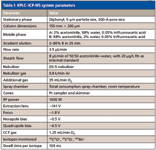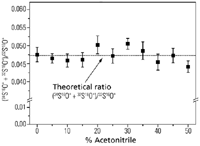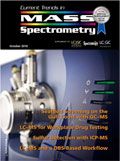Reliable and Efficient Sulfur Detection in Proteins Using ICP-MS with Capillary LC
Special Issues
With recent research, the University of Oviedo's analytical spectrometry research group has taken a step closer to the absolute quantification of proteins. Quantification based upon isotope dilution mass spectrometry of sulfur is hampered by gas-based polyatomic interferences. By implementing a quadrupole inductively coupled mass spectrometer with collision/reaction cell technology, the group has been able to overcome the issues and has increased reliability while optimizing the efficiency of its analyses.
The analytical spectrometry research group at the University of Oviedo, Asturias, Spain, was founded more than 20 years ago to develop analytical science and solve the analytical challenges encountered by science and technology. Considering that such problems can be incredibly diverse, the analytical methods used by the group in its studies must be able to cope with each specific problem or challenge. The group consists of over 30 members, each of whom specializes in a field of analytical chemistry. This enables the group to establish specialized research groups for all of its projects and utilize the individual expertise of each of its members across areas including atomic spectrometry, molecular spectrometry, and coupling of separation with specific detectors.
To extend the group's research, Dr. Jörg Bettmer has established a small subgroup within the analytical spectrometry research group under the supervision of Professor Alfredo Sanz-Medel. His work is focused on the development of inductively coupled plasma–mass spectrometry (ICP-MS)-based analytical methods for the quantification of biopolymers such as DNA and proteins. For this, the group uses two different strategies: heteroatom-tagged protein and DNA analysis, and chemical labeling strategies by means of metal-containing compounds. Within these strategies, isotope dilution mass spectrometry (IDMS) techniques play an important role. These techniques also are used within the group for the direct determination of trace elements in petroleum products as well as in nanoparticle material research.
One of the principle analytical challenges faced by the research group is the interference from gas-based polyatomics such as oxygen in the determination of sulfur when using a low-resolution instrument. To overcome these issues the group has implemented a quadrupole inductively coupled mass spectrometer with a collision/reaction cell (CRC) design. Combined with the instrument's use of ion–molecule reactions of S+ with O2 to form SO+, the system can overcome the group's issues and provide accurate determination of sulfur isotopes.
Quantitative Protein Analysis
Quantitative protein analysis is currently one of the most ambitious challenges in analytical chemistry. Mass spectrometric techniques such as electrospray ionization–mass spectrometry (ESI-MS) and matrix-assisted laser desorption ionization–mass spectrometry (MALDI-MS) play a major role in protein analysis. However, the potential of ICP-MS recently has been recognized for the determination of proteins (1,2). Although ICP-MS detection does not provide any structural information, its outstanding potential in quantifying most of the elements give an additional and complementary value to the field of protein quantification.
Potential targets of ICP-MS detection in proteins are metals incorporated in metalloproteins and metalloenzymes, selenium in selenium-containing proteins and selenoproteins, phosphorus occurring as posttranslational modifications in proteins and peptides, and finally, sulfur as a natural constituent of the amino acids cysteine and methionine. Sulfur is expected to be present in about 70% of all proteins of a biological sample. Therefore, its determination can serve as an alternative tool for quantification of proteins with a known amino acid sequence and with a known number of sulfur-containing amino acids.
Sulfur detection by ICP-MS is hampered mainly by two facts. First, the high first ionization potential (10.36 eV) that is responsible for the decreased ionization of this element in the ICP source, and second, the occurrence of spectral interferences on m/z 32 and 34. The main interference on 32S+ and 34S+, the most abundant sulfur isotopes, derive from O2+ species: 16O16O+ and 16O18O+, respectively. However, less abundant molecular ions like 31P1H+, 14N18O+, 15N16O1H+ (on 32S+), 32S1H1H+ and 16O16O1H1H+ (on 34S+), have to be considered as well for interference-free sulfur detection. Although the use of the instrumentation can easily separate all these molecular species from the elemental ions in the medium resolution mode (m/Δm = 4000), the interferences are more challenging for ICP-MS instruments based upon a collision cell design (3,4).
The University of Oviedo's analytical spectrometry group aims to optimize its mass spectrometer for reliable sulfur detection and its application to the determination of sulfur-containing standard proteins. The use of oxygen in the collision cell was chosen for the removal of spectral interferences by the formation of the SO+ species. Instrumental parameters were optimized by using the ratio of the SO+ species that contain the two major isotopes of sulfur (m/z = 48 and 50). Under optimal conditions (summarized in Table I) the separation of proteins by reversed-phase capillary liquid chromatography (LC) coupled to the mass spectrometer was demonstrated.

Table I: HPLCâICP-MS system parameters
Experimental
An XSERIES 2 ICPQ-MS (Thermo Fisher Scientific, Bremen, Germany) ICP-MS system was used throughout this work. Equipped with CRC, the instrument was optimized for the interference-free detection of sulfur. This was achieved by utilizing the ion–molecule reaction between S+ and O2 to shift the analyte to SO+ species (S+ + O2 → SO+ + O) detected at m/z 48 and 50, respectively (5). Important parameters of the CRC were optimized for the expected ratio of m/z 48 to 50 (after mass bias correction) as well as for maximum sensitivity (6).
The instrument was coupled to a capillary LC system equipped with a reversed-phase diphenyl column for protein separation (Table I). Reversed-phase chromatographic separations usually require the use of organic modifiers like methanol or acetonitrile. The introduction of these organics into the ICP system causes severe problems like plasma instability and carbon deposition on the cones. A simple solution is the reduction of the total flow rate from the milliliter-per-minute range (as in normal-bore high performance liquid chromatography [HPLC]) to the low microliters-per-minute range (capillary LC). However, these lower flow rates (in the range of 10 µL/min) require specially designed nebulizers and spray chambers for an efficient sample introduction. The interface used throughout this work consisted of a µ-flow nebulizer (DS-5) adapted to a total consumption spray chamber similar to the set-up described by Lobinski's group (7). For efficient carbon removal, oxygen was added directly into the spray chamber (35 mL/min), which also significantly reduced any signal suppression caused by the introduction of the organic modifier (8). This set-up provides stable conditions in terms of signal stability and sensitivity over several hours, even if 100% acetonitrile is introduced.
Results and Discussion
To guarantee an interference-free elemental detection of sulfur, the ratio between m/z 48 and 50 was monitored and compared to the expected one (m/z ratio of 50/48 = 0.04726). Figure 1 demonstrates the observed ratio as a function of the acetonitrile concentration introduced into the system via the chromatographic set-up. Within the uncertainty level, no significant influence on the ratio could be observed. This indicates that interference-free detection of the two sulfur isotopes is possible after their reaction with oxygen in the collision cell. Furthermore, these results show that changes in plasma conditions, here the introduction of different concentrations of acetonitrile, does not significantly influence the efficiency of the CRC. This opens the door for applications related to sulfur speciation, in which gradient elution is necessary for species separation.

Figure 1: Monitored m/z ratio 50/48 in dependence on the acetonitrile concentration in the mobile phase.
Three standard proteins that contain a definitive number of sulfur-containing amino acids including human serum albumin (M = 66.4 kDa containing 35 cysteines and 6 methionines), β-lactoglobulin (M = 18.3 kDa, 5 Cys and 4 Met), and ovalbumin (M = 42.8 kDa, 6 Cys and 16 Met) were analyzed using the described capillary LC–ICP-MS system. As shown in Figure 2, the proteins are well separated in the capillary LC column. Both ovalbumin and human serum albumin showed quite distinctive peak tailing and broadening, respectively, due to posttranslational modifications (glycosylations and phosphorylations) present in these proteins. As these micro heterogeneities are not present in β-lactoglobulin, this protein was eluted with a significantly sharper peak. From the protein amino acid sequence and the number of sulfur-containing amino acids, the sulfur amount can be directly related to the absolute amount of the protein as shown in Figure 2. The detection limit achievable for sulfur detection using the LC–ICP-MS coupling was determined to be 34 pg absolute. This corresponds to a detection limit for human serum albumin of about 26 fmol.

Figure 2: Chromatogram of three sulfur-containing proteins.
However, it needs to be mentioned that column recovery is the main restrictive problem in the application of LC to the quantitative analysis of proteins. Here, polarity, size and probably post-translational modifications might be the decisive factors in terms of the nature of the individual protein, which can lead to unequal adsorption effects. Isotope dilution concepts, such as protein-specific isotope dilution with enriched sulfur-containing amino acids, might offer a significant improvement in achieving more accurate quantitative results.
Conclusions
The coupling of LC with the ICP-MS system was realized and demonstrated by the analytical spectrometry research group to be a viable tool for the analysis of standard proteins. The proteins are able to be determined via their sulfur content naturally present in the amino acids, cysteine and methionine. ICP-MS detection parameters of sulfur were optimized within this experiment for the ion-molecule reaction of S+ with O2 to SO+ in the CRC and the obtained isotope ratio (m/z 48 and 50) was in strong agreement with the calculated one. This isotope ratio remained constant independently of the concentration of organic modifiers like acetonitrile introduced into the plasma source. Although in this instance it is confined to the application of protein analysis, the coupling of reversed-phase capillary LC and ICP-MS in general can be seen as a promising tool for the analysis of further analytes containing heteroelements like sulfur and phosphorus in many different sample types and analytical fields (4). By implementing the new instrumentation the research group has been able to overcome the issues it faced in providing accurate determination of sulfur isotopes.
Meike Hamester and Shona McSheehy are with Thermo Fisher Scientific and Daniel J Kutscher, Tobias Konz, and Jörg Bettmer are with the University of Oviedo, Spain.
References
(1) A. Sanz-Medel, M. Montes-Bayón, M.d.R. Fernández de la Campa, J. Ruiz Encinar, and J. Bettmer, Anal. Bioanal. Chem. 390, 3–16 (2008).
(2) A. Prange and D. Pröfrock, J. Anal. At. Spectrom. 23, 432–459 (2008).
(3) T. Prohaska, C. Latkoczy, and G. Stingeder, J. Anal. At. Spectrom. 14, 1501–1504 (1999).
(4) T. Lindemann, Application Note 30076, Thermo Fisher Scientific (2007).
(5) D.R. Bandura, V.I. Baranov, and S.D. Tanner, Anal. Chem. 74, 1497–1502 (2002).
(6) K.G. Heumann, S.M. Gallus, G. Rädlinger, and J. Vogl, J. Anal. At. Spectrom. 13, 1001–1008 (1998).
(7) D. Schaumlöffel, J.R. Encinar, and R. Lobinski, Anal. Chem. 75, 6837–6842.
(8) N. Zinn, R. Krüger, P. Leonhard, and J. Bettmer, Anal. Bioanal. Chem. 391, 537–543.

New Study Reviews Chromatography Methods for Flavonoid Analysis
April 21st 2025Flavonoids are widely used metabolites that carry out various functions in different industries, such as food and cosmetics. Detecting, separating, and quantifying them in fruit species can be a complicated process.
Quantifying Terpenes in Hydrodistilled Cannabis sativa Essential Oil with GC-MS
April 21st 2025A recent study conducted at the University of Georgia, (Athens, Georgia) presented a validated method for quantifying 18 terpenes in Cannabis sativa essential oil, extracted via hydrodistillation. The method, utilizing gas chromatography–mass spectrometry (GC–MS) with selected ion monitoring (SIM), includes using internal standards (n-tridecane and octadecane) for accurate analysis, with key validation parameters—such as specificity, accuracy, precision, and detection limits—thoroughly assessed. LCGC International spoke to Noelle Joy of the University of Georgia, corresponding author of this paper discussing the method, about its creation and benefits it offers the analytical community.













